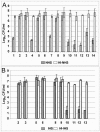Intraspecies and temperature-dependent variations in susceptibility of Yersinia pestis to the bactericidal action of serum and to polymyxin B
- PMID: 16239530
- PMCID: PMC1273868
- DOI: 10.1128/IAI.73.11.7324-7331.2005
Intraspecies and temperature-dependent variations in susceptibility of Yersinia pestis to the bactericidal action of serum and to polymyxin B
Abstract
Lipopolysaccharide (LPS) structure impacts the bactericidal action of cationic peptides, such as polymyxin B (PMB), and sensitivity to killing by normal human serum (NHS). Cultivation of different subspecies strains of Yersinia pestis isolated from unrelated geographic origins at various temperatures (mammals, 37 degrees C; fleas, 25 degrees C; or winter hibernation, 6 degrees C) affects LPS composition and structure. We tested the susceptibilities of various strains of Y. pestis grown at these different temperatures to PMB and serum bactericidal killing. Both properties varied significantly in response to temperature changes. In Y. pestis subsp. pestis (the main subspecies causing human plague), high levels of resistance to PMB and NHS were detected at 25 degrees C. However, at the same temperature, Y. pestis subsp. caucasica was highly sensitive to PMB. At both of the extreme temperatures, all strains were highly susceptible to PMB. At 25 degrees C and 37 degrees C, Y. pestis subsp. caucasica strain 1146 was highly susceptible to the bactericidal activity of 80% NHS. All Y. pestis strains studied were able to grow in heat-inactivated human serum or in 80% normal mouse serum. At 6 degrees C, all strains were highly sensitive to NHS. Variations in the PMB resistance of different bacterial cultures related to both the content of cationic components (4-amino-4-deoxyarabinose in lipid A and glycine in the core) and a proper combination of terminal monosaccharides in the LPS. The NHS resistance correlated with an elevated content of N-acetylglucosamine in the LPS. Structural variation in the LPS of Y. pestis correlates with the organism's ability to resist innate immunity in both fleas and mammals.
Figures


References
-
- Achtman, M., G. Morelli, P. Zhu, T. Wirth, I. Diehl, B. Kusecek, A. J. Vogler, D. M. Wagner, C. J. Allender, W. R. Easterday, V. Chenal-Francisque, P. Worsham, N. R. Thomson, J. Parkhill, L. E. Lindler, E. Carniel, and P. Keim. 2004. Microevolution and history of the plague bacillus, Yersinia pestis. Proc. Natl. Acad. Sci. USA 101:17837-17842. - PMC - PubMed
-
- Alekseev, A. N., V. A. Bibikova, N. M. Khrustselevskaia, and Z. K. Kantarbaeva. 1972. Characteristics of the action and nature of a bactericidal factor in the flea intestine. Parazitologiya 6:338-345. (In Russian.) - PubMed
-
- Anisimov, A. P. 1999. Factors providing the blocking activity of Yersinia pestis. Mol. Genet. Mikrobiol. Virusol. 4:11-15. (In Russian.) - PubMed
-
- Anisimov, A. P. 2002. Factors of Yersinia pestis providing circulation and persistence of plague pathogen in ecosystems of natural foci. Mol. Gen. Mikrobiol. Virusol. 4:3-11. (In Russian.) - PubMed
Publication types
MeSH terms
Substances
LinkOut - more resources
Full Text Sources
Medical

